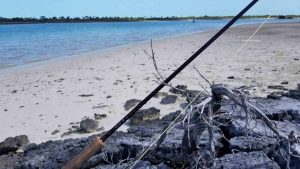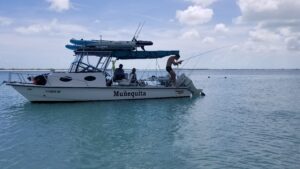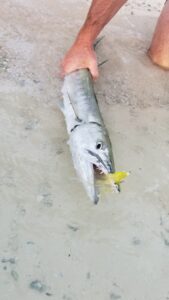Barracuda Fly Fishing in the Bahamas: Broken Lines, the Blues and a Red Sunrise
Pursuit of the barracuda can leave anglers with broken tackle…and hearts, as Justin Karnopp recently discovered on a fly fishing adventure in the Bahamas.

An initial scan revealed a marauding missile, the outline of the fish was umistakable and I was about to get my shot at a big barracuda. From a high vantage, sun at my back, I had a frigatebird’s-eye view of a translucent lagoon. I’d followed two sets of barefoot tracks inland, from the sea, and discovered flats fishing paydirt. I took a deep breath, calmed my nerves, and assessed the scene, scanning the shoreline for potential hazards that could snag a fly line or otherwise, botch my efforts.
I held the fly I had tied weeks before in my Montana basement, when this trip was but a calendar notation, and tested the purchase on the loop-to-loop connection between the hard mono and the wire leader. Satisfied, I crept gingerly over the rocks, set my bonefish rod down on the bank, and waded into the tepid water.  The fish was a long double-haul away, patrolling the shallow flat with a shifty demeanor. I was only shin-deep, and dared not move any closer. I guesstimated the distance and dumped an appropriate amount of fly line on the water. With one anxious cast, the gaudy yak hair fly landed in surprising proximity to the fish, and I immediately gave it a hard strip. The barracuda cranked a hard left and pounced. I did what I could when a guy is rusty and in the salt, but the fight didn’t last long and my elation was momentarily replaced by the despondence of losing a great fish, then quickly remedied by the awe of “That just actually happened!!” I reeled my backing and fly line in and assessed my rig. There was no damage to the wire or mono, the fish had simply spat the fly. It could’ve been a fluke, but I wasn’t going to take any chances on my short trip to the Bahamas. That night, back at the pad, I used 30lb. wire to add trailer hooks to all of my ‘cuda flies. Now I really yearned to land one.
The fish was a long double-haul away, patrolling the shallow flat with a shifty demeanor. I was only shin-deep, and dared not move any closer. I guesstimated the distance and dumped an appropriate amount of fly line on the water. With one anxious cast, the gaudy yak hair fly landed in surprising proximity to the fish, and I immediately gave it a hard strip. The barracuda cranked a hard left and pounced. I did what I could when a guy is rusty and in the salt, but the fight didn’t last long and my elation was momentarily replaced by the despondence of losing a great fish, then quickly remedied by the awe of “That just actually happened!!” I reeled my backing and fly line in and assessed my rig. There was no damage to the wire or mono, the fish had simply spat the fly. It could’ve been a fluke, but I wasn’t going to take any chances on my short trip to the Bahamas. That night, back at the pad, I used 30lb. wire to add trailer hooks to all of my ‘cuda flies. Now I really yearned to land one.

A red sunrise set the bay aglow. My buddy, Metcalf, and I drank our coffee as I removed the hooks from a rapala attached to a spinning rod. Scheming a little game of cat-and-mouse off the rock pier, I walked out to the land’s end, hucked the crank bait and began the retrieve. A yard-long ‘cuda manifested out of the turtle grass and gave chase. The bait-and-switch was in play, and I ripped the teaser from the water just before the fish caught it, then jumped behind Metcalf as he threw the fly at the fish. Instantly the ‘cuda turned, opened its maw, head shook, and fled for open water. With the drag cranked, Metcalf slowed the fish, walked down from the pier, and calmly, cooly, beached it.


We returned to the inland lagoon that afternoon, and laid up in the same zone as the day prior, was the big dastard! It had to be the same fish? Yesterday, it ate an 8-inch brown/white “Happysock”, so, logically, I changed colors and dropped down a size. Initially, the fish ignored the fly, furthering my suspicion that it was indeed the same one, but the ‘cuda eventually took notice. Rather than bum rush the fly, it slowly followed, curious, yet suspicious, and I stripped faster, agitating the fish. I tried to keep my composure at the intimidating sight of the huge ‘cuda swimming right up to me and taking the fly just off my rod tip! Now I had a dilemma and only an instant to solve it. A pile of fly line that had been coiled in the water around me was a disaster in the making as the ‘cuda made a moon-shot for safety. I tried to clear it, but the line wrapped around the reel seat and I knew I was doomed. The fly line went taut and snapped in half, my rod tip came apart and the fish went skipping across the lagoon.

En route to our favorite beach to relax for the afternoon, a flock of dive-bombing terns interrupted our commute. Metcalf maneuvered the Minequita into casting range of the mayhem while our wives grabbed spinning rods armed with crankbaits and took respective positions on the bow and stern. Small jacks breached the water below the birds and the girls started in on ‘em. Even during such a feeding frenzy, matching-the-hatch is crucial, and by the time we figured out what the fish were eating, the party was over. However, the commotion drew the interest of an apex ‘cuda, a massive fish 5-feet long circled the boat and I rushed to the bow with my fly rod. Loaded with an 8-inch red and white articulated fly, I cast at the fish and began my retrieve. My heart pounded in my chest as the fish followed the fly and promptly ate it. I was tight to the largest barracuda I had ever hooked! The fish ripped line, sounded, and tested the spine of the 8 weight. The leviathan had to weigh 70 or 80 pounds and just about the time it occurred to me that we were going to have an interesting experience dealing with this fish on the back of the boat, the line went limp and the ‘cuda slipped into the depths. I reeled in to discover that the fish had gnawed through the 30lb wire.
 Though I’ve encountered and caught barracuda over the years, these instances have been chance encounters while prowling the flats for bones, permit, or ‘poons. This sojourn to the southern Bahamas marked the first time that I had specifically targeted the species. I failed to land a single big barracuda, and a retooling of tackle is in order. I had been loaded for bear when I needed to be loaded for sharks. The wire and loop-to-loop connections that I have relied upon for big pike and average ‘cuda did not withstand the tussles with the beasts of the Bahamas. Shark anglers, like Conway Bowman, run a bite tippet utilizing single-strand stainless wire, and I think this is the recipe for big ‘cuda too.
Though I’ve encountered and caught barracuda over the years, these instances have been chance encounters while prowling the flats for bones, permit, or ‘poons. This sojourn to the southern Bahamas marked the first time that I had specifically targeted the species. I failed to land a single big barracuda, and a retooling of tackle is in order. I had been loaded for bear when I needed to be loaded for sharks. The wire and loop-to-loop connections that I have relied upon for big pike and average ‘cuda did not withstand the tussles with the beasts of the Bahamas. Shark anglers, like Conway Bowman, run a bite tippet utilizing single-strand stainless wire, and I think this is the recipe for big ‘cuda too.
If you fancy the pursuit of pike and musky, you will love fishing for barracuda. They are highly intelligent predators, inexplicably fast, and capable of breaking any but the stoutest of fly tackle. Stealth and the element of surprise are the keys to success. Like Esox, once a fish is interested in your fly, strip it faster, as everything runs from a Barracuda!


